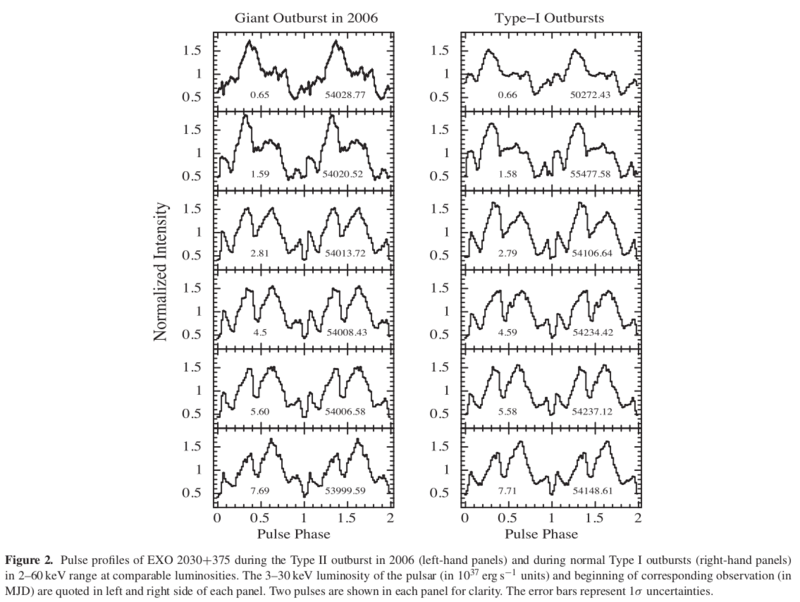EXO 2030+375
Other Names
- V2246 Cyg (SIMBAD)
Monitoring Data:
Fermi/GBM Swift/BAT MAXI BeXRB-Monitor
General Characteristics
- Discovered 1985 by EXOSAT ([1])
- Optical companion: B0 Ve ([2])
- Distance: [math]\displaystyle{ 7.1,\text{kpc} }[/math] ([3])
- Very reliable Type I outburst at around ~100 mCrab over 10-20 days ([3])
- Three giant outburst to far stretching several months each: 1986, 2006 & 2021
- Kozai-Lidov oscillations in the Be-disk as possible driver of giant outbursts [4])
- ~0.2 Hz QPO ([5]) with luminosity dependent frequency ([6])
Orbital Parameters
- Orbital period: [math]\displaystyle{ P_{\text{Orb}} = 46.0211(3)\,\text{d} }[/math] ([7])
- Epoch of periastron passage: [math]\displaystyle{ T_0 = 52802.20(1)\,\text d }[/math] ([7])
- Projected semimajor axis:[math]\displaystyle{ a_{\text x}\sin i = 248(12)\,\text{lt-s} }[/math] ([7])
- Eccentricity:[math]\displaystyle{ e = 0. 0.409(1) }[/math] ([7])
- Longitude of periastron: [math]\displaystyle{ \omega = 212.0(4)^{\circ} }[/math] ([7])
Pulsations
- Pulse profiles strongly luminosity dependent: ([8],[9])
- Two main peaks, one dominant at high and one at low luminosities
- Interpreted as switch from pencil- to fan-beam pattern
- One prominent and stable dip in pulse profile
- Another very sharp dip one at specific luminosity
- Pulse profile evolution similar between outbursts
Figure taken from [10]
Spectral Analysis
- Partially covered cutoffpl + black-body + neutral and ionized Iron lines
- Also fitted with BW07 ([11])
- Spectrum becomes harder with luminosity at lower luminosity and softer at higher luminosity ([6])
- Strong spectral changes with orbital phase:
Possible Cyclotron Features
- During Type I outburst ~36 keV ([12])
- During 2006 giant outburst ~11 keV ([7])
- During 2006 giant outburst ~63 keV ([7])
None of those is conclusively detected ([11])
References
- ↑ Cite error: Invalid
<ref>tag; no text was provided for refs namedParmar89a - ↑ Cite error: Invalid
<ref>tag; no text was provided for refs namedReig98 - ↑ 3.0 3.1 Cite error: Invalid
<ref>tag; no text was provided for refs namedWilson02 - ↑ Cite error: Invalid
<ref>tag; no text was provided for refs namedLaplace17 - ↑ Cite error: Invalid
<ref>tag; no text was provided for refs namedAngelini89 - ↑ 6.0 6.1 Cite error: Invalid
<ref>tag; no text was provided for refs namedReig13 - ↑ 7.0 7.1 7.2 7.3 7.4 7.5 7.6 Cite error: Invalid
<ref>tag; no text was provided for refs namedWilson08 - ↑ 8.0 8.1 Cite error: Invalid
<ref>tag; no text was provided for refs namedFerrigno16 - ↑ 9.0 9.1 Cite error: Invalid
<ref>tag; no text was provided for refs namedFuerst17 - ↑ Cite error: Invalid
<ref>tag; no text was provided for refs namedMcBride07 - ↑ 11.0 11.1 Cite error: Invalid
<ref>tag; no text was provided for refs namedEpili17 - ↑ Cite error: Invalid
<ref>tag; no text was provided for refs namedReig99
